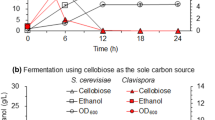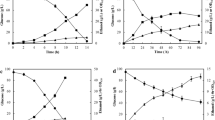Abstract
Reducing the cost of cellulosic ethanol production, especially the use of expensive exogenous cellulose hydrolytic enzymes such as cellulase and β-glucosidase, is a critical challenge and vital for a sustainable advanced biofuel industry. Here, we report a novel ethanologenic yeast strain Clavispora NRRL Y-50464 that produces sufficient innate β-glucosidase enzyme activity for cellulosic ethanol production by simultaneous saccharification and fermentation (SSF). In a bottled SSF, strain Y-50464 produced 40.44 g/L ethanol from pure cellulose within 72 h at a conversion rate of 0.04 g/L/h, applying conventional cellulase without supplementary β-glucosidase. Ethanol conversion from delignified corn stover by Y-50464 showed significantly higher titers and rates at various solids loading levels than that from conventional pretreated corn stover with over 40 to 60 % improved efficiency in a bottled SSF. However, the bottled SSF was inefficient for mixing higher levels of cellulose feedstock and should be replaced by a more suitable experimental apparatus. In a 2-L bioreactor SSF using conventional dilute acid pretreated corn stover, strain Y-50464 produced 32 g/L ethanol from 20 % solids loading at 48 h applying cellulase alone without addition of β-glucosidase. This represented a conversion rate of 0.088 g/L/h, the highest rate so far for cellulosic ethanol production from lignocellulosic materials. Elimination of β-glucosidase in cellulose-to-ethanol fermentation would be expected to reduce cost of cellulose conversion. The robustness, fast growth rate, and the capability of producing both ethanol and β-glucosidase illustrated the potential of strain Y-50464 as a potential candidate biocatalyst for advanced biofuel production from lignocellulosic biomass.




Similar content being viewed by others
References
Ballesteros M, Oliva JM et al (2004) Ethanol from lignocellulosic materials by a simultaneous saccharification and fermentation process (SFS) with Kluyveromyces marxianus CECT 10875. Process Biochem 39(12):1843–1848
Varga E, Klinke HB et al (2004) High solid simultaneous saccharification and fermentation of wet oxidized corn stover to ethanol. Biotechnol Bioeng 88(5):567–574
Ohgren K, Rudolf A et al (2006) Fuel ethanol production from steam-pretreated corn stover using SSF at higher dry matter content. Biomass Bioenergy 30(10):863–869
Olofsson K, Bertilsson M et al (2008) A short review on SSF—an interesting process option for ethanol production from lignocellulosic feedstocks. Biotechnol Biofuels 1(1):7
Lynd L, Zyl W et al (2005) Consolidated bioprocessing of cellulosic biomass: an update. Curr Opin Biotechnol 16(5):577–583
Piccolo C, Bezzo F (2009) A techno-economic comparison between two technologies for bioethanol production from lignocellulose. Biomass Bioenergy 33(3):478–491
Olson DG, McBride JE et al (2012) Recent progress in consolidated bioprocessing. Curr Opin Biotechnol 23(3):396–405
Adam AC, Rubio-Texeira M et al (1995) Induced expression of bacterial β-glucosidase activity in saccharomyces. Yeast 11(5):395–406
Shen Y, Zhang Y et al (2008) Simultaneous saccharification and fermentation of acid-pretreated corncobs with a recombinant Saccharomyces cerevisiae expressing β-glucosidase. Bioresour Technol 99(11):5099–5103
Argyros DA, Tripathi SA et al (2011) High ethanol titers from cellulose by using metabolically engineered thermophilic, anaerobic microbes. Appl Environ Microbiol 77(23):8288–8294
Gurgu L, Lafraya Á et al (2011) Fermentation of cellobiose to ethanol by industrial Saccharomyces strains carrying the β-glucosidase gene (BGL1) from Saccharomycopsis fibuligera. Bioresour Technol 102(8):5229–5236
Lee W-H, Nan H et al (2013) Simultaneous saccharification and fermentation by engineered Saccharomyces cerevisiae without supplementing extracellular β-glucosidase. J Biotechnol 167(3):316–322
Liu ZL, Weber SA et al (2012) A new β-glucosidase producing yeast for lower-cost cellulosic ethanol production from xylose-extracted corncob residues by simultaneous saccharification and fermentation. Bioresour Technol 104:410–416
Liu ZL, Weber SA (2014) Clavispora spp. strain. Unites States Patent 8,673,604. March 18, 2014
Liu ZL, Weber SA et al (2013) Isolation and characterization of a β-glucosidase from a Clavispora strain with potential applications in bioethanol production from cellulosic materials. Bioenerg Res 6(1):65–74
Chapla D, Parikh BS, Liu ZL Cotta MA, Adepu KK (2015) Mild alkali pretreatment of rice straw improves efficiency of cellulosic ethanol production using Clavispora NRRL Y-50464. J Biobased Mater Bioenerg (in press)
Gould JM (1984) Alkaline peroxide delignification of agricultural residues to enhance enzymatic saccharification. Biotechnol Bioeng 26:46–52
Jeoh T, Ishizawa CI et al (2007) Cellulase digestibility of pretreated biomass is limited by cellulose accessibility. Biotechnol Bioeng 98(1):112–122
Kim S, Holtzapple MT (2006) Effect of structural features on enzyme digestibility of corn stover. Bioresour Technol 97(4):583–591
Ishizawa CI, Jeoh T et al (2009) Can delignification decrease cellulose digestibility in acid pretreated corn stover? Cellulose 16(4):677–686
Yang B, Wyman CE (2008) Pretreatment: the key to unlocking low-cost cellulosic ethanol. Biofuels Bioprod Bioref 2(1):26–40
Koppram R, Olsson L (2014) Combined substrate, enzyme and yeast feed in simultaneous saccharification and fermentation allow bioethanol production from pretreated spruce biomass at high solids loadings. Biotechnol Biofuels 7(1):54
Acknowledgments
We are grateful to Daniel Schell from the DOE National Renewable Energy Laboratory, Golden, CO, for providing dilute acid pretreated corn stover used in this study and to Scott Weber for technical assistance. Mention of trade names or commercial products in this publication is solely for the purpose of providing specific information and does not imply recommendation or endorsement by the US Department of Agriculture. USDA is an equal opportunity provider and employer.
Author information
Authors and Affiliations
Corresponding author
Rights and permissions
About this article
Cite this article
Liu, Z.L., Cotta, M.A. Technical Assessment of Cellulosic Ethanol Production Using β-Glucosidase Producing Yeast Clavispora NRRL Y-50464. Bioenerg. Res. 8, 1203–1211 (2015). https://doi.org/10.1007/s12155-014-9575-9
Published:
Issue Date:
DOI: https://doi.org/10.1007/s12155-014-9575-9




